

Travel log Tanzania - Second visit
Sunday 15-10 (500 km)
What a day! Up at 05.00 hours and breakfast at 06.00 (at least that was the idea, but the staff of the Blue Posts cannot keep up). At 06.30 we are on the road from Thika to Nairobi Internal Airport. We arrive at the airport well in time and Eelko's father, Huub, even manages to check in his bloody soap stone statue with only 3 kg overweight. At 09.00 the three of us, Paul, Eelko and I, continue our trip to the Tanzanian border and beyond. The border crossing is uneventful and on both sides we are treated in a friendly and efficient manner. Wa Bashasha's Carnet de Passage is a magic document and the custom officers are experienced in handling the Carnet. At the Kenyan side we are charged overtime by the immigration and customs because it is a Sunday! Their Tanzanian colleagues are more realistic and just wish us a pleasant journey. The road to Arusha runs through Masai land and for the first time we notice how ecologically devastating cattle herding can be. The plains are almost transformed into desert and the signs of serious erosion are everywhere: deep gullies and even more sand. Where there are herds of cattle, you can see the dust from miles away. At 13.30 hours we drive into a real dust and sand storm and it is almost like evening. Passing Arusha, and on our way to Moshi, we discuss the future fate of the herders like the Masai. Their herds are inseparable from their culture and serve cultural rather than economical needs. Or, in other words, the herds could be much smaller if only the material needs of the Masai were to be served. As it is now, the extensive herds are a threat to the environment and the agriculturalists wish the Masai to another planet. Enough conflicting interests to guarantee a volatile situation. Shortly after Moshi we turn to the south and through the rear window Eelko sights the snow covered Kilimanjaro! At Same we know a good Motel: the Elephant Motel. Luckily they have accommodation available. After dinner we chat to a couple of Dutch volunteers and a Swedish couple travelling Africa.
Monday 16-10 (160 km)
The short rains have overtaken us! Since 08.00 hours it is pouring down and when we leave the Elephant Motel in Same , we are already ploughing through the thick, red mud. When turning out of the secure parking lot, Paul runs Wa Bashasha into a concrete pillar and seriously damages the left wing. It keeps raining and within an hour Paul and I are dripping wet. Eelko, in the rear, keeps dry. We are not able to locate where exactly the water is coming from, but a towel stops at least some of the flow. This time, the winding mountain road to Lushoto presents us with no spectacular views: we drive through the clouds. With some problems, we enter the gate to the Eugene's Hostel and find the Usambara Sisters as friendly and hospitable as ever. The lunch with home made cheese and marmalade is a treat and so is dinner later that night. Afterwards, we sit on our veranda and try to reason how the Sisters have been able to maintain such high standards. Their guest rooms are impeccable, everything works, the food is good and the service is not only professional, but also homely and friendly. Few if any guesthouses in Tanzania can meet their standards. Somehow, we feel that it has something to do with motivation and discipline prevailing in the convent. In addition, the convent also offers a “safe haven” for African women who otherwise, usually, live a very insecure life.
Tuesday 17-10 (290 km)
The rain has stopped and via Korogwe and Serena we reach Msata over an excellent tarmac road. From Msata, a corrugated dirt road leads to Bagamoyo . It is hot and dusty and to neutralize the effects of the corrugated road, Paul tries to keep Wa Bashasha at a speed of 45 miles an hour. On stony and sandy stretches, he needs all his strength to keep the steering wheel from spinning. He sweats like a pig. In the Travellers Lodge, they are expecting us. Cottage number 20 is allocated to us and Eelko is allowed to pitch up his tent next to the cottage. After dinner we order a bottle of good Chardonnay and try to forget the sticky heat.
Wednesday 18-10 (125 km)
In the morning we drive to Dar es Salaam to get money from an ATM and to buy supplies. I even manage to change some of my Kenyan shillings into Tanzanian ones, but fail to get rid of my Malawian kwachas. At midday we are back at the Travellers Lodge and make lunch ourselves before going to an Internet café. As usual, half of the equipment is out of order and the connection is excruciatingly slow. Nevertheless, we manage to give our webmaster Marc some work by sending him travel logs and find a sailing schedule for Wa Bashasha. It is not practical to ship her from Cape Town to Lisbon, but Vigo in northern Spain appears to be a good choice. We will propose this destination to Intersped in Cape Town and Roald in the Netherlands and wait for their reaction.
Thursday 19-10 (190 km)
Mbande Village Clinic project day! At 09.00 we are at TAMECO and Remigius is already waiting for us. There is some panic since he had expected us to be back on 26 th October, but soon we do business as usual. At 10.00 we are at the panel beater workshop and within an hour the damage Wa Bashasha sustained in Same has been repaired. The wing is reasonably straight again and the new green paint matches the old one. Total costs: Tshilling 20.000 or approximately US$ 20. Paul wishes we could stay for an extra week to have the entire car re-sprayed.
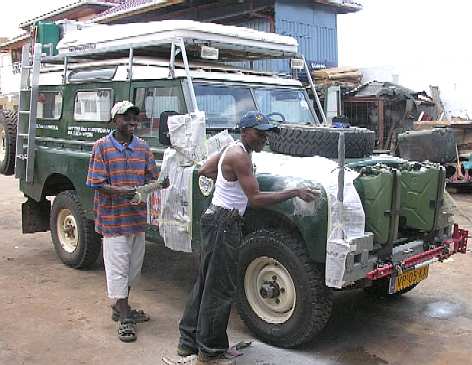
P
anel beaters at work in the workshop in Dar es Salaam
At midday we are in Mbande and almost get stuck in the sand leading to the clinic. The bore hole has been completed and yields 3000 l per hour. Most of the building materials have arrived and are stored in the laboratory building. The bad news is that the water quality is not optimal.
The turbidity is too high (the water is too dirty) and there is too much salt in the water. Part, if not all, of these problems may result from the rent drilling and, in consultation with the water people, we decide to pump for two or three weeks to see whether the quality improves. If not, we can try to pump from 60 instead of 80 metres. The worst case scenario being that a new bore hole will have to made elsewhere. After two hours, we drive to Remigius' house to have a lunch prepared by Dominica.
Friday 20-10 (190 km)
From Roald we hear that Wa Bashasha can be shipped from Cape Town somewhere around 26 th November and will arrive in Vigo, Spain, around 10 th December. We ask Roald to confirm this with Intersped and to book tickets to fly to Vigo on 1 st December. As we understand now, Paul, Eelko and I, will fly from Cape Town to Johannesburg and from there to Madrid. Eelko will then fly directly back to Amsterdam and we to Vigo. There we intend to hire a car and visit Rachel Kemball in Portugal and then wait for Wa Bashasha to arrive. If all goes well, the admirable old La(n)dy should be on the road for the last stretch of our journey by 12 th December. To our cottage in Sibratsgfäll will take another 5 days, but it would be nice to arrive there on 15 th , Paul's birthday. We will stay there for a couple of days and be back in Veldhoven before Christmas. After breakfast, we are off to Mbande again.
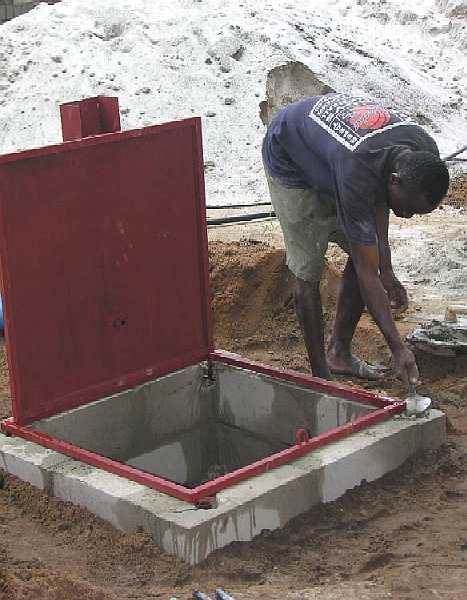
Mbande Village Clinic: work on the bore hole is progressing well.
The protective casing is almost ready.
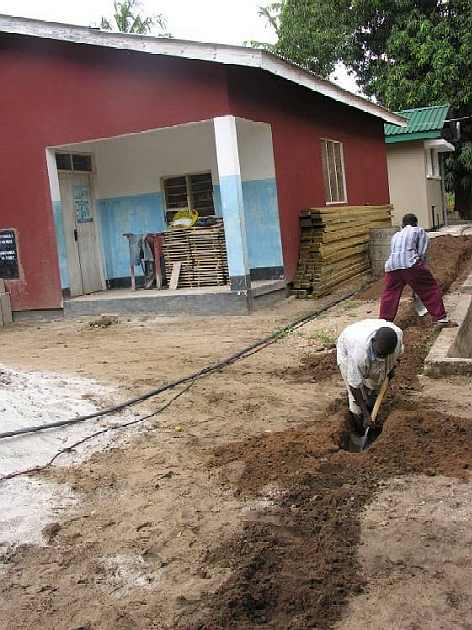
Mbande Village Clinic: the villagers are digging the trench
to connect the bore hole with the water tanks.
The work on the clinic is in full swing. The anchor stones for the roof beams are cemented into place and ducts are chiselled into the cement block walls for the electricity pipes. The latter, of course, can only be used if TANESCO keeps to its promise to finish the last part of the grid!! Next to the clinic, masons are finishing the protective stone fence around the bore hole and a group of labourers lay the water pipe from the well to the two 5000 litres tanks. Let's hope and pray that the water quality improves in the weeks to come.
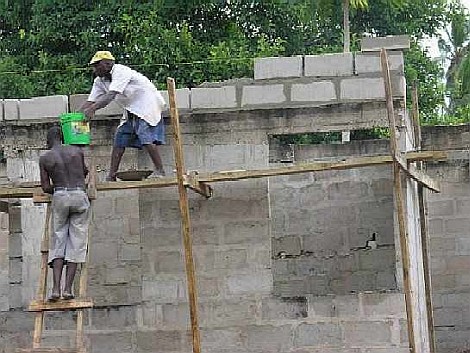
Mbande Village Clinic: the anchor stones for the roof beams are set.
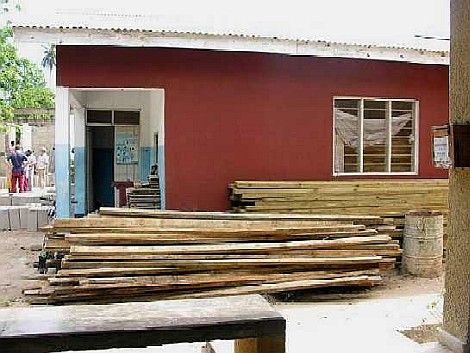
Mbande Village Clinic: the roof beams themselves
– the wood is treated against termites – are stored inside and in the open air.
Hopefully the short rains will be delayed by another two weeks!
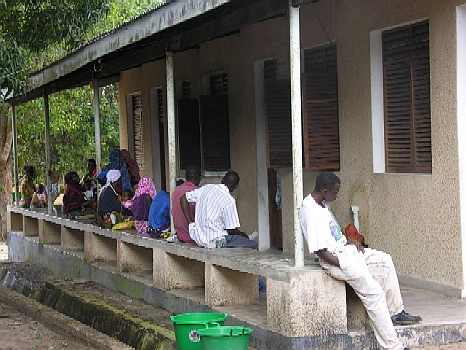
Mbande Village Clinic: in the rush of all the building excitement
let us not forget what it is all about: providing a basic health care facility in a rural village! As you can see, there is no lack of patients.
Remigius is still badgering us about a function, next week, with the Districts Commissioner, the Municipal Director and hotshots from the Ministery of Health. In the end we manage to convince him that it is better to have the function somewhere in May 2007, when both the borehole and the clinic are fully operational. At that time, we suggest to stay in Mbande for a week. It is already late when we leave Mbande and we do not manage to get back to Bagamoyo before dark.
Saturday 21-10 (5 km)
I am unhappy … I suffer from a stomach disorder again. It must have been the Swahili seafood platter of last night, but Paul thinks this unlikely. His stomach, however, is like that of a pig. At 09.00 we are at the Internet café again, communicating with Intersped and our webmaster. Then we clean and repack the car, which takes the better part of the day. I am still feeling unwell and I am glad we have an air conditioner in the cottage.
Sunday 22-10 (140 km)
I sleep badly, but in the early morning the Diacure eventually starts working and at 11.00 we are on our way to Dar es Salaam again to lunch with our friends and their families: Remigius, Dominica, their children and grand children and Francis and Dafrosa and three of their kids. At the Nyerere Cultural Centre we enjoy our food, chat and eventually have a brief ceremony to commemorate that we all know each other for almost 30 years. To our utter surprise Remigius presents us with a huge wooden case, the size of a small coffin. When we open it, we find an almost life-size canoe with wood carved rowers representing the Mbwala and Lapperre families. In view of the size and weight of the present, and with Wa Bashasha's load capacity in mind, Paul blanches. However, we accept the present in good humour and later that night re-arrange Wa Bashasha's rear compartment. Eelko's living space is yet again reduced.
Monday 23-10 (475 km)
Farewell Bagamoyo … Cape Town here we come! The dirt road from Bagamoyo towards Kibaha, leading to the A7 towards Mikumi, has just been graded and we make excellent progress. By the time we are on the tarmac again, we have saved some two hours. The A7 cuts through Mikumi National Park and, luckily for Eelko, we see elephants, giraffes, buffalo, baboons and various types of gazelles.
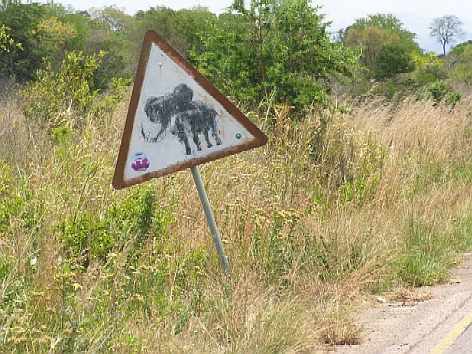
Along the road in Mikumi National Park, Eelko sees his first elephant!
In Mikumi village itself, we stop at the Tan Swiss restaurant and have an excellent lunch. Sometimes on our travels we find amazingly pleasant places and this is one of them. The road to Iringa is much better than when we passed it three months ago and all potholes have been filled! Apparently, and contrary to our earlier ideas, Tanzania has a working road maintenance schedule. Take heed Kenyans, you can learn a lot from your Tanzanian brethren! The very steep climb up the mountains, before we reach Iringa, is too much for Wa Bashasha. Her electrical petrol pump fails too and only produces gas. We let her cool down for half an hour and then climb even higher. In one of the last hairpin curves, we meet a 20 tonnes lorry coming down on the wrong side of the road. Paul steers Wa Bashasha almost into the rock face and with only a couple of inches to spare we escape a serious accident or worse. At the top of his voice, Paul yells his customary collection of multi-lingual abuse at the Tanzanian driver. It takes me some time to lower Paul's blood pressure. Eelko, not yet accustomed to these outbursts, looks a little taken aback. At 16.00 hours we arrive at the MR Hotels in Iringa. Little has changed since we were there last time and after a sober dinner we turn in early.
Tuesday 24-10 (320 km)
Again a long day ahead of us. Once on the road from Iringa to Mbeya , we are soon in Tanzania's wood producing forests. Kilometre after kilometre of pine and gum trees. Mature forest, young forest and hundreds of hectares of felled trees. A saw mill now and then. There are an unusual number of road blocks today, but Paul's latest “act” works wonders. Slowly approaching the road blocks, he gives a smart military salute. Usually the police officer or army soldier hesitates a second and then has no option but to return the salute and wave us through! To day we are only stopped once and asked what the standard on the car's wing is. When Paul answers that it is the standard of the Caribbean Command of the Royal Dutch Navy, we are waved through again! Being the old staff car of that command, I am sure Wa Bashasha smiles. When we arrive at the Stockholm Hotels in Mbeya, it is oppressively warm and we sit in the shade in the garden and sip some cold drinks. The hotel itself has not changed since three months ago. Clean rooms and reasonable food for a reasonable price but … the weirdest bathroom designs we have ever seen. The shower is directed at the toilet, the towel rack and the wash basin. Make therefore sure that, before you take a shower, you go to the toilet first, then remove all the towels and finally clear the shelf over the wash basin. After showering, first dry the toilet properly unless you don't mind sitting on a wet seat later.
Wednesday 25-10 (440 km)
Our last couple of hours in Tanzania. The road from Mbeya to Tunduma (border post) is excellent and we drive along coffee fields and well kept stone houses. Apparently this is a rather wealthy part of Tanzania. The Tanzanian customs and immigration officers are efficient and friendly, but on the Zambian side the customary chaos prevails. We cannot avoid a “guide” and visit five different offices with him. All is dirty and disorganised and once again we have the feeling that in Zambia everyone wants to take advantage of you. For the first time during our trip, we are forced to buy a completely superfluous third party insurance. We leave the border post highly annoyed and wonder why Zambia's government does not put its border posts right. As they are, they are a disgrace to the nation. The next 350 km we drive through an empty land. Hardly any people – let alone market activities – along the road, no villages, no small scale agriculture and no cattle. A charcoal depot now and then and twice a food relief go-down of the United Nations.
The turn off to Shiwa Ngandu House and the Kapishya Hot Springs Campsite is clearly indicated and after another 40 km of gravel road we arrive at the Campsite. We find the prices for the chalets and for dinner unacceptably high and decide to camp and self-cater. The campsite is dusty and the facilities are meagre. As far as we are concerned, try to avoid Kapishya Hot Springs Camp.
© 2005-2006 Paul and Meta Lapperre - Website by MvS
